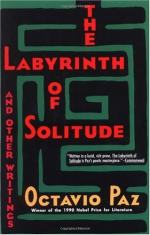
|
| Name: _________________________ | Period: ___________________ |
This test consists of 15 multiple choice questions and 5 short answer questions.
Multiple Choice Questions
1. What type of book did Xavier Villaurrutia write?
(a) Death-related poetry.
(b) Religious exhortations about life.
(c) Life-related poetry.
(d) A scientific explanation of death.
2. According to Paz, what is death in modern thought?
(a) The putting to rest of all sorrow.
(b) The predictable end to a natural progression.
(c) The avoidable end to a wasted life.
(d) The end of all unworthy men.
3. What do a pachuco's actions and lifestyle demonstrate?
(a) His desire to return to Mexico.
(b) His will to remain different.
(c) His dissatisfaction with North American culture.
(d) His anger at a culture that will not assimilate him.
4. Paz discusses the result of persecution on the pachuco. What is that result?
(a) It strengthens his anger.
(b) It makes him stronger.
(c) It breaks his solitude.
(d) It makes him distrustful.
5. According to Paz, what is the Mexican's relationship with his fellow man?
(a) He changes him to Nobody.
(b) He respects him only if he is revered.
(c) He ignores him.
(d) He respects him only if they are the same social class.
6. What does Paz deem to be the first and most serious change that a man endures when he becomes a worker?
(a) He stops earning what he is worth.
(b) He loses communion with his fellow man.
(c) He loses his sense of the Divine.
(d) He loses his individuality.
7. What model do Mexicans prefer that the woman follow?
(a) A general model of decency, secrecy, and long-suffering.
(b) The model of ancient Mexican goddesses.
(c) A model of strength, praise, and fortitude.
(d) The model of The Virgin Mary - chaste and kind.
8. In contrast to the North American, what is one of the most noticeable traits about the Mexican character?
(a) His obsession with love.
(b) His acceptance of horror.
(c) His disinterest in emotional attachments.
(d) His aversion to horror.
9. Paz says that during critical moments in a nation's development, the people ask themselves a critical question. What is that question?
(a) How can we move forward?
(b) How do we want the future to look?
(c) Who should lead us?
(d) Who are we and how can we fulfill this obligation?
10. In Paz's estimation, what vital word has the Mexican forgotten?
(a) The word tying him to life forces of creativity and destruction.
(b) The word that gives him peace with all others.
(c) The word of love given to him by his mother.
(d) The word that allows him to reach out to others.
11. Aside from being an excess, what does the fiesta revolt against?
(a) Life.
(b) Death.
(c) Form.
(d) Sadness.
12. How do Mexicans perceive an opening-up of one's self?
(a) As a betrayal or weakness.
(b) As a sign of strength.
(c) As a moment of truth.
(d) As infidelity to the human spirit.
13. What is the novelty of the pachuco clothing?
(a) Its colors.
(b) Its exaggeration.
(c) Its disregard for current fashion.
(d) Its impracticality.
14. According to Paz, what does it mean when a person is alone?
(a) He can never relate to other people.
(b) He is inferior.
(c) He is superior.
(d) He is different.
15. How does Paz differentiate between views of the body in Mexico and North America?
(a) Mexicans are afraid of their bodies, while North Americans are modest.
(b) Mexicans are ashamed of their bodies, while North Americans live with physical exuberance.
(c) Mexicans are modest, while North Americans are afraid of their bodies.
(d) Mexicans live with abandon while North Americans are prudent.
Short Answer Questions
1. When Paz first arrived in the United States, what surprised him most about the people?
2. What mentality does Paz attribute to the Mexican?
3. What did Paz find in the actions and faces of North Americans?
4. What does the Mexican value in art, religion, and politics?
5. Other than solitude, what does the Mexican often feel in relation to other peoples?
|
This section contains 659 words (approx. 3 pages at 300 words per page) |

|




